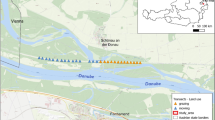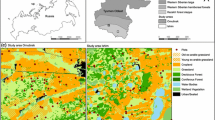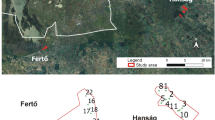Abstract
Long-term studies on the population dynamics of grasshoppers are rare, and are even missing completely for the alpine regions of Central Europe. Here the effects of climate warming and the recent changes in land use, like abandonment of pasturing, are believed to be serious. Our study on an alpine grasshopper community over 30 years allows, for the first time, the long-term description and analysis of these processes in the northern part of the Alps. In the years 1991–2020 the distribution and abundance of grasshoppers (Orthoptera) was surveyed annually with a standardized method on fixed plots in the Hohe Tauern National Park (Salzburg, Central Alps, Austria) in elevations between 2070 and 2440 m. During the study period five Orthoptera species Melanoplus frigidus, Miramella alpina, Omocestus viridulus, Gomphocerus sibiricus and Pseudochorthippus parallelus were present. This species spectrum did not change during the 30 years of study. The number of species per plot and year varied between 0 and 4, this value increased significantly during the 30 years. The yearly fluctuation rate of the abundance was very large, especially for G. sibiricus, its maximum abundance reached 40 times the minimum value. All species—with the exception of the boreo-alpine M. frigidus—increased their range at the study site slowly but continuously. A significant increase in abundance was only detected in O. viridulus. During the study the mean temperature in the vegetation period increased significantly by 1.6 °C. Snow cover in June at the hatching of the nymphs varied greatly but did not change during the 30 years. The closest relationship between weather and abundance was found for G. sibiricus, whose occurrence is significantly determined by the temperature in June. But the increase in temperature did not lead to higher abundance during the study period. With increasing temperature, the abundance of M. frigidus was positively affected by cooling weather like higher precipitation in May and high snow cover in June. M. alpina was favored by late thaw and showed reduced densities in years with high temperature in summer. Climate warming favored the ubiquitous species P. parallelus, which enlarged its distribution continuously into higher elevations, and O. viridulus increasing its abundance. The abandonment of grazing had no negative effect on species composition and abundance in the long term. There was even a tendency for increased abundance, especially in M. alpina. Cyclical fluctuations in the abundance of certain species prove that eggs hibernate more than one winter under these alpine conditions. G. sibiricus exhibits a biennial, M. alpina even a triennial life-cycle, the latter is maybe also the case in M. frigidus. In contrast to this, P. parallelus seems to be mainly univoltine. Climate warming, which is more pronounced in the study site than in Central Europe in general, favors mainly widespread generalist species, while the most characteristic species of alpine habitats M. frigidus does not profit from this development. The negative effects of warming on M. alpina has so far been compensated by the abandonment of grazing, which has probably led to a more suitable vegetation structure. The proof of bi- and triannual life-cycles in the studied populations of alpine grasshoppers increases the knowledge of their potential plasticity. These strategies seem to be an important prerequisite to colonize such extreme habitats and to overcome occasional events of harsh weather conditions.
Implications for insect conservation
Our results show that the long-term influence of climate warming in alpine habitats leads to different reactions of species, favoring generalists that expand their range and increase their densities, while specialized alpine species do not profit or even show negative reactions to warmer and dryer conditions. This highlights the potential extinction risk of range-restricted species living at high elevations. The abandonment of grazing with heavy cattle, which was common in the study site at the beginning, did not lead to significant changes in the grasshopper-community. Conventional grazing is not necessary to preserve the biodiversity of these communities at such high elevations above the forest line. The study also exhibited only slow changes in the grasshopper-populations masked by very pronounced fluctuations in abundance, which underlines the importance of long-term studies to understand the dynamics in these extreme habitats and elaborate conservation measures.








Similar content being viewed by others
References
Aichhorn K, Kurtz I (2007) Monitoring im Sonderschutzgebiet Piffkar 2004–2005: positive Vegetationsentwicklung aufgrund natürlicher Sukzession nach Beendigung der Beweidung? Report Nationalpark Hohe Tauern, Salzburg. 121 pp
Aigner S, Egger G (2017) An application example for modeling grazing intensity: Nationalpark Hohe Tauern. In: 6. Symposium for research in protected areas. Conference volume: 1–4. 2 to 3 November 2017, Faculty of Natural Science, University of Salzburg, Austria, Nationalpark Hohe Tauern
Asshoff R, Köhler G (2003) Zur Biologie der alpinen Gebirgsschrecke, Miramella alpina (Kollar, 1833) (Acrididae: Cantantopinae). Jb Naturf Ges Graubünden 112:5–18
Bazelet DS, Samways MJ (2011) Identifying grasshopper bioindicators for habitat quality assessment of ecological networks. Ecol Ind 11(5):1259–1269
Bazelet CS, Gardiner T (2018) Orthoptera response to grazing: an introduction to the special issue. J Orthoptera Res 27(1):1–2
Berger M (1988) Mehrjährige ökologische Untersuchungen an einer Grashüpfer-Population (Orthoptera: Acrididae). Inaugural Dissertation, Philipps-Universität Marburg/Lahn, 157 pp
Blumer P, Diemer M (1996) The occurrence and consequences of grasshopper herbivory in an alpine grassland, Swiss Central Alps. Arct Alp Res 28(4):435–440
Bruckhaus A (1992) Ergebnisse zur Embryonalentwicklung bei Feldheuschrecken und ihre Bedeutung für den Biotop- und Artenschutz. Articulata Beiheft 2:1–115
Carron G (1996) Do alpine acridids have a shortened post-embryonic development? Articulata 11(1):49–72
Cornelius HP, Clar E (1939) Geologie des Großglocknergebietes, Teil 1. Abh. der Zweigst. Wien der Reichstelle für Bodenforschung 35, 306 pp
Dempster JP (1963) The population dynamics of grasshoppers and locusts. Biol Rev 38:490–529
Detzel P (1998) Die Heuschrecken Baden-Württembergs. Verlag Eugen Ulmer, Stuttgart, p 580
Fartmann T, Krämer B, Stelzner F, Poniatowski D (2012) Orthoptera as ecological indicators for succession in steppe grassland. Ecol Ind 20:337–344
Fielding DJ, Brusven MA (1990) Historical analysis of grasshopper (Orthoptera: Acrididae) population responses to climate in Southern Idaho, 1950–1980. Environ Entomol 19(6):1786–1791. https://doi.org/10.1093/ee/19.6.1786
Fielding DJ, Defoliart LS (2010) Embryonic developmental rates of northern grasshoppers (Orthoptera: Acrididae): implications for climate change and habitat management. Environ Entomol 39(5):1643–1651
Finch OD, Löffler J, Pappe R (2008) Assessing the sensitivity of Melanoplus frigidus (Orthoptera: Acrididae) to different weather conditions: a modeling approach focussing on development times. Insect Sci 15(2):167–178
Frank W (1969) Geologie der Glocknergruppe. In: Büdel J, Glaser U (eds) Neue Forschungen im Umkreis der Glocknergruppe. Wissenschaftl, vol 21. Alpenvereinshefte, Deutscher Alpenverein, Munich, pp 95–112
Gardiner T, Dover J (2008) Is microclimate important for Orthoptera in open landscapes? J Insect Conserv 12:705–709. https://doi.org/10.1007/s10841-007-9104-7
Grabherr G (2003) Overview: alpine vegetation dynamics and climate change—a synthesis of long-term studies and observations. In: Nagy L, Grabherr G, Körner Ch, Thompson DBA (eds) Alpine biodiversity in Europe. Springer, Berlin, Heidelberg, pp 399–409
Grabherr G, Mucina L (1993) Die Pflanzengesellschaften Österreichs Teil II. Natürliche waldfreie Vegetation. Gustav Fischer, Jena, Stuttgart, New York
Griehser B (unpubl.) Botanische Dauerbeobachtungen im Sonderschutzgebiet Piffkar (Glocknergruppe). Unpublished manuscript, Salzburg
Griehser B, Pfeifer K (1998) Botanische Dauerbeobachtungen im Sonderschutzgebiet Piffkar (Glockner-Gruppe)—Vegetationsökologisches Monitoring 1992–1996. Report Nationalpark Hohe Tauern, Salzburg
Gueguen-Genest MC, Gueguen A (1987) Effet du paturage ovin sur la dynamique de population du criquet de Sibérie Gomphocerus sibiricus Finot Orthoptère, acrididae dans une formation paturée d'altitude. C. R. Acad. Sc. Paris, t. 304, Série III, n°17:443–447
Haeberli W, Hoelzle M, Paul F, Zemp M (2007) Integrated monitoring of mountain glaciers as key indicators of global climate change: the European Alps. Ann Glaciol 46:150–160
Illich I (unpubl.) Data on Orthoptera assemblages, stored in the database of ARGE Heuschrecken Österreichs, Wien
Illich IP (1993) Heuschreckengemeinschaften (Orthoptera: Saltatoria) in alpinen und subalpinen Habitaten der Hohen Tauern. Quantitative Bestandsaufnahmen im Nationalpark-Sonderschutzgebiet Piffkar (Salzburg, Austria). Wiss. Mitt. Nationalpark Hohe Tauern, pp 184–97
Illich I (2017a) Sibirische Keulenschrecke Gomphocerus sibiricus (Linnaeus, 1767). In: Zuna-Kratky T, Landmann A, Illich I, Zechner L, Essl F, Lechner K, Ortner A, Weißmair W, Wöss G (eds) Die Heuschrecken Österreichs. Denisia 39:719–724
Illich I (2017b) Nordische Gebirgsschrecke Melanoplus frigidus (Boheman, 1846). In: Zuna-Kratky T, Landmann A, Illich I, Zechner L, Essl F, Lechner K, Ortner A, Weißmair W, Wöss G (eds) Die Heuschrecken Österreichs. Denisia, vol 39, pp 544–548
Illich I (2019) Fachbereich: Heuschrecken, Studie 4. In: Wittmann H, Neumayer J, Schied J, Klarica J, Gros P, Illich I (eds) Ökologisches Pistenmanagement. Zur Biodiversität von Skipisten auf der Schmittenhöhe. Studie der Schmittenhöhebahn AG 2018/19. Rupertusverlag, Goldegg, pp 150–191
Illich IP, Winding N (1989) Aut- und Synökologie der Feldheuschrecken (Acrididae: Orthoptera) einer subalpinen/alpinen Almweide (Gasteinertal, Hohe Tauern, Österreich): Habitat und Nahrung. Zool Jb Syst 116:121–131
Illich IP, Haslett JR (1994) Responses of assemblages of Orthoptera to management and use of ski slopes on upper sub-alpine meadows in the Austrian Alps. Oecologia 97:470–474
Illich IP, Winding N (1998) Die Heuschrecken (Orthoptera: Saltatoria) der Hohen Tauern: Verbreitung, Ökologie, Gemeinschaftsstruktur und Gefährdung. Wiss. Mitt. Nationalpark Hohe Tauern 4:57–158
Illich IP, Winding N (1999) Dynamik von Heuschrecken-Populationen (Orthoptera: Saltatoria) in subalpinen und alpinen Rasen des Nationalparks Hohe Tauern (Österreichische Zentralalpen) von 1990-1997. Wiss. Mitt. Nationalpark Hohe Tauern 5:63–85
Illich I, Werner S, Wittmann H, Lindner R (2010) Die Heuschrecken Salzburgs. Salzburger Natur-Monographien 1. Haus der Natur Salzburg, 255 pp
Ingrisch S (1995) Phänologie und Abundanz der Heuschrecken in der alpinen Stufe am Muottas Muralgl, Engadin (Orthoptera: Acrididae). Mitt Schweiz Entomol Ges 68:7–22
Ingrisch S (1996) Fekundität und Entwicklung alpiner Feldheuschrecken (Orthoptera: Acrididae). Mitt Schweiz Entomol Ges 69:441–455
Ingrisch S, Köhler G (1998) Die Heuschrecken Mitteleuropas. Neue Brehm-Bücherei 629. Westarp Wissenschaften, Magdeburg, p 460
Joern A, Pruess KP (1986) Temporal constancy in grasshopper assemblies (Orthoptera: Acrididae). Ecol Entomol 11:379–385
Jonas JL, Wolesensky W, Joern A (2015) Weather affects grasshopper population dynamics in continental grassland over annual and decadal periods. Rangel Ecol Manag 68(1):29–39
Klinge M, Lehmkuhl F (1998) Zur Differenzierung des periglazialen Formenschatzes nach ökologischen Standortfaktoren im Piffkar. Wiss. Mitt. Nationalpark Hohe Tauern 4:207–223
Köhler G (1983) Untersuchungen zum Schlupfpolymorphismus und dessen intrapopularen Folgen bei Chorthippus parallelus (Zetterstedt) (Orthoptera: Acrididae). Zool Jb Syst Jena 110:31–44
Köhler G (1991) Investigations on diapause and non-diapause in Central European grasshopper eggs (Acrididae: Gomphocerinae). Zool Jb Syst 118:323–344
Köhler G, Brodhun HP (1987) Untersuchungen zur Populationsdynamik zentraleuropäischer Feldheuschrecken (Orthoptera: Acrididae). Zool Jb Syst 114:157–191
Köhler G, Perner J, Schuhmacher J (1999) Grasshopper population dynamics and meteorological parameters—lessons from a case study. Ecogeography 22:205–212
Körner C (2003) Alpine plant life: functional plant ecology of high mountain ecosystems. Springer, Berlin, p 344
Körner C, Tappeiner U, Newesely C, Wittmann H, Eberl T, Kaiser R, Meyer E, Grube M, Mendoza FF, Füreder L, Niedrist GH, Daim A, Lieb G, Kellerer-Pirkelbauer A, Wickham S, Petermann J, Berninger U (2020) Langzeitmonitoring von Ökosystemprozessen Synthese der Startphase 2016–2018. 72 pp. Verlag der österr. Akademie der Wissenschaften, Wien. https://doi.org/10.1553/GCP_LZM_NPHT_Synthese
Landmann A (2017) Vom Großglockner zum Neusiedler See: Die Vertikalverbreitung der Heuschrecken Österreichs. In: Zuna-Kratky T, Landmann A, Illich I, Zechner L, Essl F, Lechner K, Ortner A, Weißmair W, Wöss G (eds) Die Heuschrecken Österreichs. Denisia 39:87–110
Landmann A, Zuna-Kratky T (2016) Die Heuschrecken Tirols. Berenkamp, Innsbruck. 304 pp
Lieb GK, Kellerer-Pirklbauer (2017) Monitoring of abiotic natural processes in the Hohe Tauern National Park, Austria: a long-term approach. In: 6. Symposium for research in protected areas. Conference volume:379–381. 2 to 3 November 2017, Faculty of Natural Science, University of Salzburg, Austria, Nationalpark Hohe Tauern
Monnerat C, Thorens P, Walter T, Gonseth Y (2007) Rote Liste der Heuschrecken der Schweiz. Bundesamt für Umwelt, Bern & Schweizer Zentrum für Kartographie der Fauna, Neuenburg, pp 62
Nadig A (1986) Ökologische Untersuchungen im Unterengadin—Heuschrecken (Orthoptera). Ergeb Wiss Unters Schweiz Nationalpark 12(10):103–170
Nadig A (1991) Die Verbreitung der Heuschrecken (Orthoptera: Saltatoria) auf einem Diagonalprofil durch die Alpen (Inntal-Maloja-Bregaglia-Lago di Como-Furche). Jahresber. Naturforsch. Ges. Graubünden NF. 106:380 pp
Patzner RA, Illich I (2021) Eine einfache Methode zur Darstellung und zum Monitoring der Schneebedeckung. Naturwissenschaftliche Rundschau 74:500–501
Peer T (1993) Die Bodenformen im Sonderschutzgebiet Piffkar. Wiss Mitt Nationalpark Hohe Tauern 1:34–42
Schichtel HM, Stern R (1985) Die aktuelle Vegetation der Hohen Tauern. Matrei in Osttirol und Großglockner; Vegetationskarten 1:25000 mit Erläuterungen. Nationalpark Hohe Tauern Wiss. Schriften, Universitätsverlag Wagner, Innsbruck, 64 pp
Slotta-Bachmayr L, Ringl C, Winding N (1998) Faunistischer Überblick und Gemeinschaftsstruktur von Kleinsäugern in der Subalpin- und Alpinstufe im Sonderschutzgebiet Piffkar, Nationalpark Hohe Tauern. Wiss Mitt Nationalpark Hohe Tauern 4:185–206
Spatz G, Mühlschlegel F, Jussel U, Weis GB (1989) Zur Futterqualität von Pflanzenbeständen entlang eines Höhengradienten an der Glocknerstraße. Veröff. Österr. MaB-Hochgebirgsprogramm Hohe Tauern 13, Innsbruck, pp 515–529
Stemmer M, Peer T (1996) Untersuchungen zum Nährstoffhaushalt beweideter und nicht mehr beweideter Almflächen im Sonderschutzgebiet Piffkar (Nationalpark Hohe Tauern). Wiss Mitt Nationalpark Hohe Tauern 2:7–17
Stevanovic D (1961) Ekologija i dinamika populacije Aeropus sibiricus L. na Kopaoniku. Bio. Inst. N.R. Srbihe, Posebna Izdanja, Beograd 8:1–87
Tappeiner U, Cernusca A (1989) Veränderung der Bestandesstruktur und der Lichtausnutzung nach dem Brachfallen einer Almweide.Veröff. Österr. MaB-Hochgebirgsprogramm Hohe Tauern 13, Innsbruck, pp 531–547
Taucher W, Kellerer-Pirklbauer A, Lieb GK, Avian M (2009) Climate change in alpine areas in central Austria between 1961 and 2006. In: 14th Symposium of the Hohe Tauern National Park for research in protected areas. Conference volume 305–310. September 17th to 19th, 2009, Castle of Kaprun
Tollner H (1969) Klima, Witterung und Wetter in der Großglocknergruppe. Neue Forschungen im Umkreis der Glocknergruppe. Wiss. Alpenvereinshefte 21:83–94
Uvarov BP (1977) Grasshoppers and locusts: a handbook of general Acridology, vol 2. Centre for Overseas Pest research, London, p 613
Welti E, Roeder KA, de Beurs KM, Joern A, Kaspari M (2020) Nutrient dilution and climate cycles underlie declines in a dominant insect herbivore. Proc Natl Acad Sci USA. https://doi.org/10.1073/pnas.1920012117
Werner S, Slotta-Bachmayr L, Winding N (1999) Populationsdynamik von Vögeln in zwei Probeflächen der Subalpin- und Alpinstufe im Nationalpark Hohe Tauern (1990–1995). Wiss. Mitt. Nationalpark Hohe Tauern 5:87–111
White EG, Sedcole JR (1991) A 20-year record of alpine grasshopper abundance, with interpretations for climate change. N Z J Ecol 15(2):139–152
Widmer S, Riesen M, Krüsi BO, Dengler J (2020) Wenn Gämsen Schafe ersetzen: Fallstudie zu den Auswirkungen auf die Diversität von alpinen Rasen. Tuexenia 40:225–246
Zuna-Kratky T, Karner-Ranner E, Lederer E, Braun B, Berg HM, Denner M, Bieringer G, Ranner A, Zechner L (2009) Verbreitungsatlas der Heuschrecken und Fangschrecken Ostösterreichs. Verlag Naturhistorisches Museum Wien, Wien, p 304
Acknowledgements
Our special thanks go to Norbert Winding, director of the Haus der Natur, Museum of Nature and Technology in Salzburg, the original initiator of the long-term monitoring in the Piffkar. We also thank Eberhard Stüber, former director of the Haus der Natur for the financial support in some years of the study. We are grateful to Alexander Ohms (Zentralanstalt für Meteorologie und Geodynamik), Elke Ludewig (ZAMG Sonnblick Observatory) and Anne Kasper-Giebl (Technical University of Vienna) for providing data on climate and air pollutants in our study area. We thank the Hohe Tauern National Park in Salzburg for the permission to access the protected area “Piffkar”. Katharina Aichhorn, Hohe Tauern National Park Carinthia provided important literature and unpublished data on the vegetation. We are very grateful to Sabine Werner for valuable discussions and manuscript improvements, to Georg Bieringer for his supporting comments and to Benjamin Seaman for a critical review of the English version of the manuscript. Zoltán Kenyeres and an anonymous reviewer gave valuable comments for the improvement of the final manuscript. Furthermore we thank director Johannes Hörl for free use of the Großglockner Hochalpenstraße and the Haus der Natur for the opportunity to use the Eberhard Stüber research station for alpine studies. We also thank Christian Dullnig, director of the agricultural school at Bruck/Glocknerstraße for inspection of the cattle fences in the Piffkar.
Author information
Authors and Affiliations
Corresponding author
Ethics declarations
Conflict of interest
The authors declare that they have no conflict of interest.
Additional information
Publisher's Note
Springer Nature remains neutral with regard to jurisdictional claims in published maps and institutional affiliations.
Appendix
Appendix
See Tables 1, 2, 3, 4, 5, 6, 7, 8 and 9.
Rights and permissions
About this article
Cite this article
Illich, I., Zuna-Kratky, T. Population dynamics of an alpine grasshopper (Orthoptera) community over 30 years and the effects of climate warming and grazing. J Insect Conserv 26, 435–451 (2022). https://doi.org/10.1007/s10841-022-00381-8
Received:
Accepted:
Published:
Issue Date:
DOI: https://doi.org/10.1007/s10841-022-00381-8




